We can interpolate fairly easy using splines. To extrapolate we could use a polynomial model. Let's give the data a flag first to keep control of the results.
dd$flag <- 0
Interpolation
To use the individual doy (what actually is it? was day meant?) ranges, we create a data.frame of the respective sequences using do.call (we also could do seq.int(min(x$doy), max(x$doy))) and merge it to the original data. Next we perform a spline interpolation and replace just the NAs.
res1 <- by(dd, dd$gp, \(x) {
a <- cbind(merge(x[-3], data.frame(doy=do.call(seq.int, as.list(range(x$doy)))), all=TRUE), gp=el(x$gp))
na <- is.na(a$cumsum)
int <- with(a, spline(doy, cumsum, n=nrow(a)))$y
transform(a, cumsum=replace(cumsum, na, int[na]), flag=replace(flag, is.na(flag), 1))
}) |> do.call(what=rbind)
res1
# doy cumsum gp
# a.1 4 4.000000 a
# a.2 5 5.333333 a
# a.3 6 6.666667 a
# a.4 7 8.000000 a
# a.5 8 9.333333 a
# a.6 9 10.666667 a
# a.7 10 12.000000 a
# a.8 11 12.500000 a
# a.9 12 13.000000 a
# a.10 13 13.500000 a
# a.11 14 14.000000 a
# a.12 15 14.500000 a
# b.1 5 8.000000 b
# b.2 6 9.166667 b
# b.3 7 10.333333 b
# b.4 8 11.500000 b
# b.5 9 12.666667 b
# b.6 10 13.833333 b
# b.7 11 15.000000 b
# b.8 12 16.666667 b
# b.9 13 18.333333 b
# b.10 14 20.000000 b
# d.1 5 10.000000 d
# d.2 6 12.000000 d
# d.3 7 14.000000 d
# d.4 8 16.000000 d
# d.5 9 18.000000 d
# d.6 10 20.000000 d
# d.7 11 24.000000 d
# d.8 12 28.000000 d
# d.9 13 32.000000 d
# d.10 14 36.000000 d
# d.11 15 40.000000 d
Looks like this:
plot(cumsum ~ doy, res1, type='n')
by(res1, res1$gp, \(x) with(x, points(doy, cumsum, type='b', pch=20, col=flag + 1)))

See this answer for linear interpolation using approx.
Alternatively, if you need the doy at all equal periods, e.g. 2:20, we first follow the same approach, because spline would omit the NAs. At the end we merge the result to an extra data.frame containing the complete period.
res1a <- by(dd, dd$gp, \(x) {
a <- cbind(merge(x[-3], data.frame(doy=do.call(seq.int, as.list(range(x$doy)))), all=TRUE), gp=el(x$gp))
na <- is.na(a$cumsum)
int <- with(a, spline(doy, cumsum, n=nrow(a)))$y
df <- transform(a, cumsum=replace(cumsum, na, int[na]), flag=replace(flag, is.na(flag), 1))
merge(df, data.frame(doy=2:20, gp=el(a$gp)), all=TRUE) |> {\(.) .[order(.$doy), ]}()
}) |> do.call(what=rbind)
res1a
head(res1a)
# doy gp cumsum flag
# a.1 2 a NA NA
# a.2 3 a NA NA
# a.3 4 a 4.000000 0
# a.4 5 a 5.712121 1
# a.5 6 a 7.272727 1
# a.6 7 a 8.681818 1
Extrapolation
Similarly we do to to extrapolate, but use a polynomial lm with say degree=2 (but is rather too few, but more won't work with the few available values in this example) and use the predictions,
res2 <- by(dd, dd$gp, \(x) {
a <- cbind(merge(x[-3], data.frame(doy=2:20), all=TRUE), gp=el(x$gp))
na <- is.na(a$cumsum)
int <- predict(lm(cumsum ~ poly(doy, degree=2), x), newdata=a)
int[int < 0] <- 0 ## to prevent negative values
transform(a, cumsum=replace(cumsum, na, int[na]), flag=replace(flag, is.na(flag), 1))
}) |> do.call(what=rbind)
res2
# doy cumsum flag gp
# a.1 4 4.000000 0 a
# a.2 5 5.333333 1 a
# a.3 6 6.666667 1 a
# a.4 7 8.000000 1 a
# a.5 8 9.333333 1 a
# a.6 9 10.666667 1 a
# a.7 10 12.000000 0 a
# a.8 11 12.500000 1 a
# a.9 12 13.000000 1 a
# a.10 13 13.500000 1 a
# a.11 14 14.000000 1 a
# a.12 15 14.500000 0 a
# b.1 5 8.000000 0 b
# b.2 6 9.166667 1 b
# b.3 7 10.333333 1 b
# b.4 8 11.500000 1 b
# b.5 9 12.666667 1 b
# b.6 10 13.833333 1 b
# b.7 11 15.000000 0 b
# b.8 12 16.666667 1 b
# b.9 13 18.333333 1 b
# b.10 14 20.000000 0 b
# d.1 5 10.000000 0 d
# d.2 6 12.000000 1 d
# d.3 7 14.000000 1 d
# d.4 8 16.000000 1 d
# d.5 9 18.000000 1 d
# d.6 10 20.000000 0 d
# d.7 11 24.000000 1 d
# d.8 12 28.000000 1 d
# d.9 13 32.000000 1 d
# d.10 14 36.000000 1 d
# d.11 15 40.000000 0 d
which looks like this:
plot(cumsum ~ doy, res2, type='n')
by(res2, res2$gp, \(x) with(x, points(doy, cumsum, type='b', pch=20, col=flag + 1)))

Note, that inter/extrapolation may be problematic with few data points as in your example, but you might have more in your original data. Also for the extrapolation, you may want to check if there are significant higher polynomials in the groups, to better prevent increasing predictions to the left (see plot). Alternatively we could use non-parametric approaches such as loess.
Data
dd <- structure(list(cumsum = c(4, 12, 14.5, 8, 15, 20, 10, 20, 40),
doy = c(4, 10, 15, 5, 11, 14, 5, 10, 15), gp = c("a", "a",
"a", "b", "b", "b", "d", "d", "d"), flag = c(0, 0, 0, 0,
0, 0, 0, 0, 0)), row.names = c(NA, -9L), class = "data.frame")

